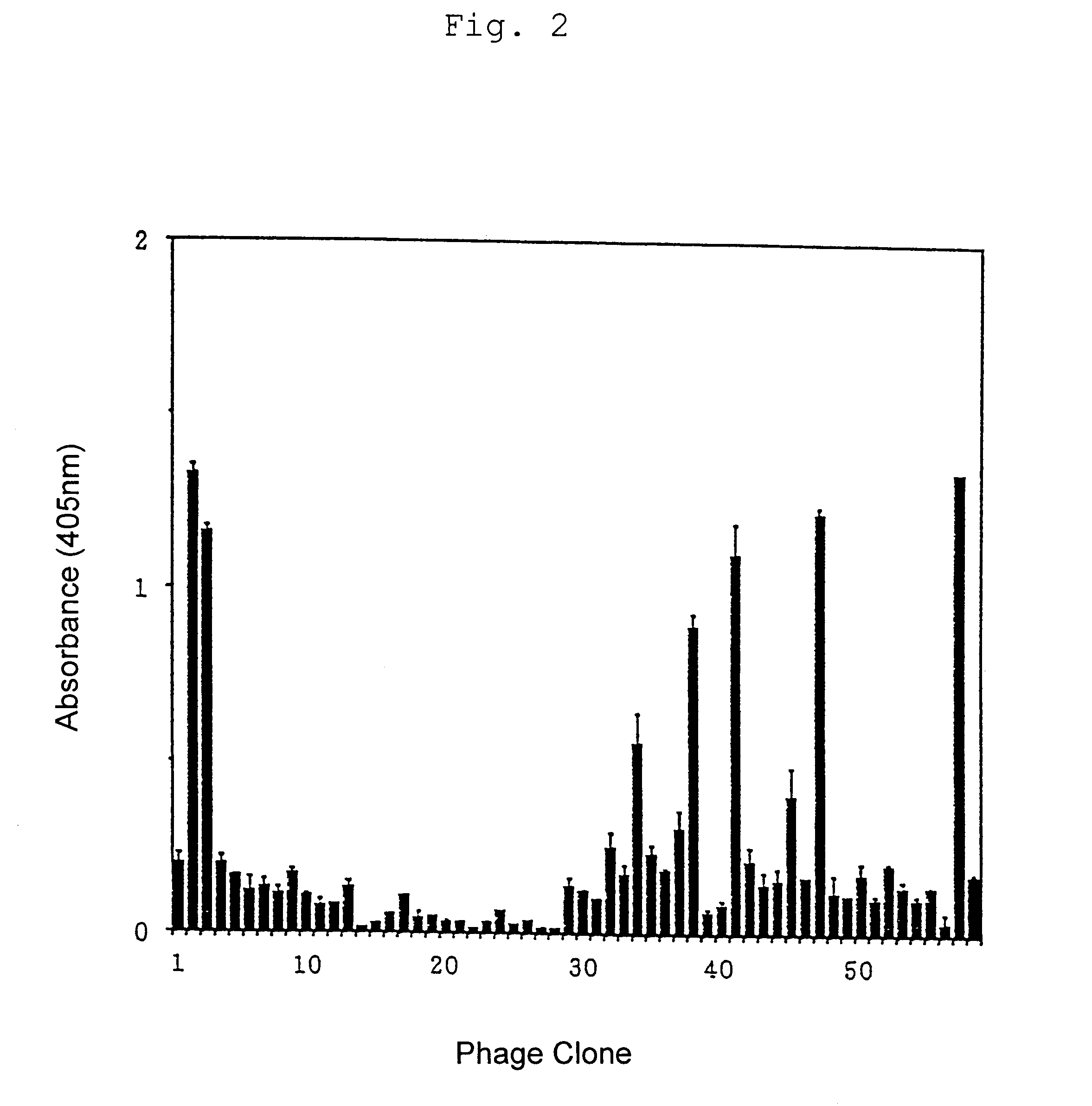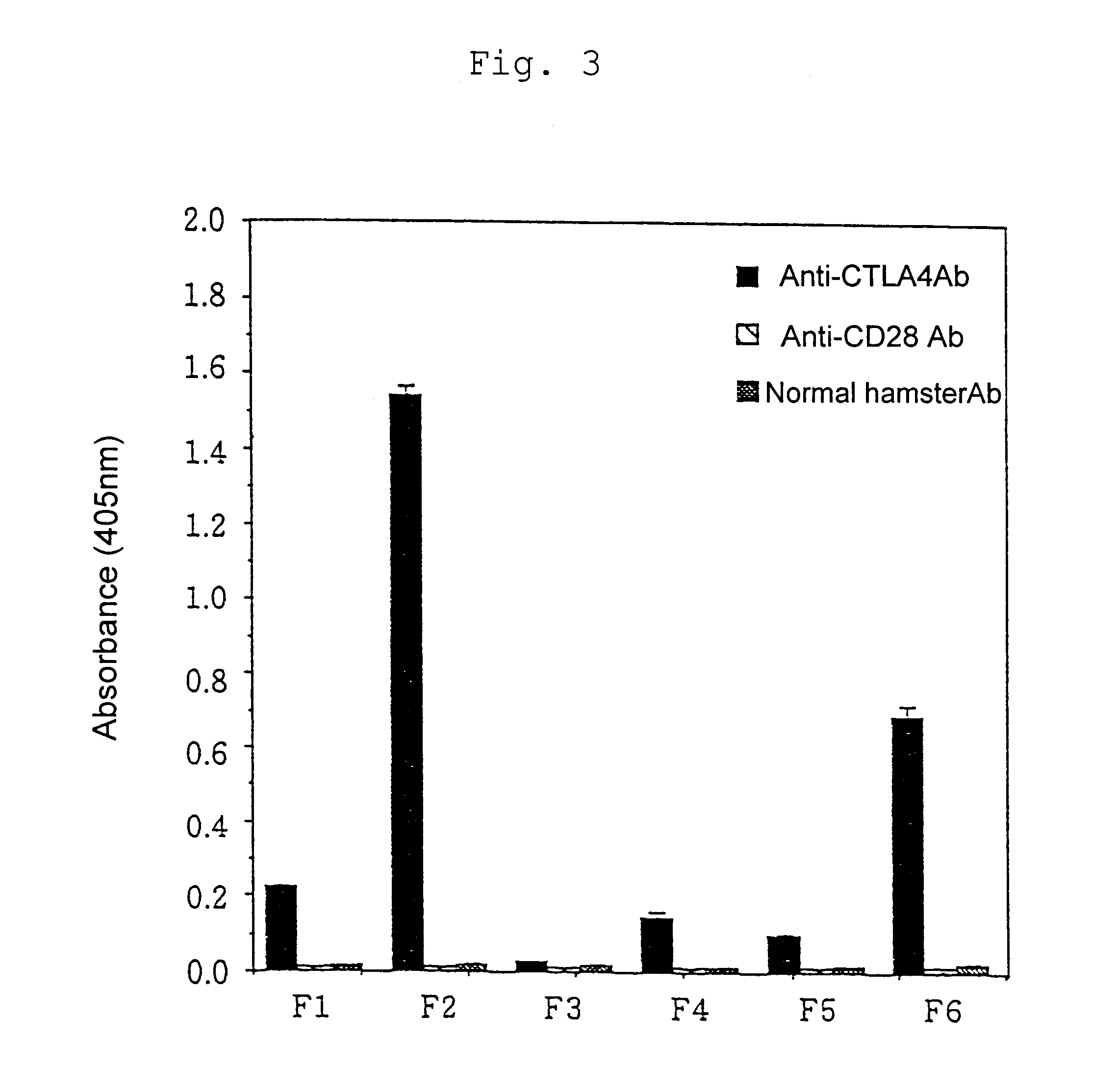Immunoregulatory molecules for costimulatory signal transduction
a costimulatory signal and immunoregulatory technology, applied in the direction of antibody medical ingredients, peptide sources, instruments, etc., can solve the problems of poor efficiency, insufficient high-efficiency antibody effect, and the inability to obtain a peptide sequence capable of regulating a ligand-receptor interaction with much difficulty, so as to accelerate the development of novel drugs
- Summary
- Abstract
- Description
- Claims
- Application Information
AI Technical Summary
Benefits of technology
Problems solved by technology
Method used
Image
Examples
example 1
Phage Random Peptide Library
Smith et al. reported a phage random peptide library wherein random genes for peptides of a length as desired are inserted into a gene (geneIII) coding for pIII protein occurring at the tip of phages and wherein phages express pIII protein bearing peptide molecules while phages continuously infect (G. P. Smith, Science, Vol. 249, p.386-390 (1990)). A primary amino acid sequence of pIII protein is shown in SEQ ID NO: 1. Genes for random amino acid sequences may be inserted at the site between the amino acids No. 22 Ala and No. 23 Gly in this primary sequence to express peptides as a fusion protein with pIII. With this procedure, as much as several 108 peptides may easily be prepared as compared to the chemical synthesis and amplification-of any gene is also possible as desired.
A phage random peptide library as used herein for screening is one prepared by Nishi, Saya et al. (T. Nishi, Experimental Medicine, Vol. 11, p.95-100 (1993)) which is prepared as des...
example 2
Activity of Antibodies Used for Screening
An object of the present invention is to provide phage clones having peptide sequences which exhibit immunoregulatory activity through interaction with CD80, CTLA-4 or molecules associated with these molecules. Thus, the phage random peptide library as in Example 1 was screened with anti-mouse CTLA-4 monoclonal antibody (UC10-4F10-11 purchased from PharMingen) to isolate phage clones specifically bound to this antibody. It is believed that motifs of fifteen amino acid residues contained in pIII of phages specifically bound to this antibody have a similar structure to that of the site on CTLA-4 molecule recognized by this antibody. Since this site is involved in interaction with the ligand as explained hereinbelow, these motifs obtained from phages also recognize CD80 / CD86 molecule and thus may influence interaction between CTLA-4 molecule and CD80 / CD86 molecule or may transmit certain signal to CD80 / CD86 molecule.
For determining specificity o...
example 3
Panning of Phage Clones Binding to Anti-CTLA-4 Antibody
Using the anti-CTLA-4 antibody which inhibited binding between CTLA-4-Ig and CD80-Ig as shown in Example 2, panning of the phage random peptide library as described in Example 1 was carried out by the following procedures.
Each of plastic plates with 35 mm diameter (Iwaki Glass, Tokyo) was coated with 1 ml of the anti-mouse CTLA-4 monoclonal antibody at 10 .mu.g / ml and reacted with the phage random peptide library (1.2.times.10.sup.12 TU) at 4.degree. C. for 16 hours. These plates were washed with TBST to remove unbound phages and then added with 0.1 N HCl-Glycine, pH 2.2 (1 mg / ml BSA, 0.1 mg / ml phenol red (Gibco, New York)) to elute phages specifically bound to the anti-mouse CTLA-4 monoclonal antibody. The bound phages were recovered and neutralized with Tris-HCl, pH 9.1. E. coli K91 kan was infected with the obtained phages and grown. With a decreased amount (5 .mu.g / ml, 1 .mu.g / ml) of the anti-mouse CTLA-4 monoclonal antibody...
PUM
| Property | Measurement | Unit |
|---|---|---|
| length | aaaaa | aaaaa |
| length | aaaaa | aaaaa |
| pH | aaaaa | aaaaa |
Abstract
Description
Claims
Application Information
 Login to View More
Login to View More - R&D
- Intellectual Property
- Life Sciences
- Materials
- Tech Scout
- Unparalleled Data Quality
- Higher Quality Content
- 60% Fewer Hallucinations
Browse by: Latest US Patents, China's latest patents, Technical Efficacy Thesaurus, Application Domain, Technology Topic, Popular Technical Reports.
© 2025 PatSnap. All rights reserved.Legal|Privacy policy|Modern Slavery Act Transparency Statement|Sitemap|About US| Contact US: help@patsnap.com



